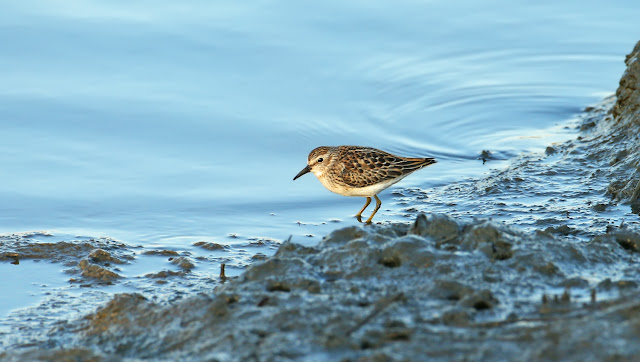The purpose of this trip was to fill the void
left by not being able to get onto Fair Isle in late September due to the
devastating fire that destroyed the Observatory building earlier in the year. I had looked at a number of options, including
Israel for the Lesser Spotted Eagle migration in late September however I eventually
chose Cape May as it had long been a bucket list destination for this migration
junky and I would be there during the peak migration period, I just had to hope
for North West winds during the trip.
Things did not get off to a very good start. Once
we arrived in the U.S. we experienced the notoriously long queues for U.S.
immigration, taking well over an hour to get through; this was then followed by
lots of phaffing around with the car rental company as they were going to give
me a piece of crap Kia Soul which was neither close to the type of car we were
expecting and was really not fit for our purpose (see the section around car
hire/rental further below). Once we finally got a better car we headed off in
the wrong direction, the signage in New York is appalling, and resulted in us
getting lost and ended up trying to work out how to get the hell out of Queens,
my maps were all based on getting us to Cape May from the Airport. This
‘detour’ of several hours going round in one-way circles meant we were then in travelling
in rush hour traffic once on the correct road and then subsequently stuck in a near
motionless traffic jam due to an accident on Staten Island. Many a wrong turn
and slow traffic meant that the 3hour expected drive took over 7hours!!!! I was
not happy bunny.
When it finally came to the birding it was often
very slow, very slow meaning dead. There were glimmers of what Cape May could
do with some North West winds mid trip giving some much needed songbird
migration here and there but numbers were generally low with many expected
species missing. Waders (shorebirds) were hard to come by and raptor passage
was slow, perhaps I’ve been spoilt by ‘real’ raptor migration in Israel. As a
result this trip ended up being my least enjoyable of any I’ve made to North
America, this being by seventh trip. Even photography was challenging and very
few ‘songbirds’ were snapped as many were high up in tall fully leafed out
trees or hiding in dense cover. I usually come back from a trip with a whole
host of photos to go through, this time around I have about a quarter of those
I would normally expect to take.
It wasn’t all doom and gloom as there were
obviously some highlights. The butterflies throughout were real winners, the
time I spent in the Cape May Bird Observatory garden sifting through the
warblers on the 25th September, finally finding a proper gathering
of waders at Edwin B. Forsythe NWR, the Black Skimmer flock, the abundant and
approachable Forster’s Terns and one to one experiences with some smashing
warblers for example.
However from talking to local, and regular
visiting, birders many had never seen it so quiet here in ‘the fall’. This may
have been as a result of Hurricane Dorien a week or so earlier messing with the
weather. A further ‘however’ though is that, as an observation made by a long-standing
local birder, is that there does appear to have been a longer downward trend in
both the frequency of ‘falls’ as a result of lack of North West Winds. There used
to be near weekly North Westerlies but now it’s just once or twice an autumn,
if you’re lucky. In addition to that is that the volume of birds are well down on
the historical numbers when it blows from the North West. I guess it’s a sign
of the times of changing weather patterns affecting bird migrations and overall
world bird populations rapidly falling.
Apart from the few scattered birding and
wildlife highlights I found myself largely bored and my motivation was long
gone by the middle of the second week of the trip; I was ready to leave after
one week but had to endure the second week. I really think Cape May is living
on reputation and past glories as it doesn’t seem to be the place it once was.
The species accounts further down this trip
report make it look like a bird filled trip but this is anything but the truth
and I think recent trip reports on Cloudbirders may also falsely imply more
birds here than there actually are.
At the end of each trip I ask myself, “will I
return?”. With my annual trips to Israel it is always an easy ‘YES I will’ as
even when it is quiet it’s never ‘this’ quiet. So for Cape May “will I
return?”, the answer is an emphatic NO. I should have enjoyed this trip more
but the place just did not gel with me so I will not return.
So with the above I have attempted to select the best images from the relatively few taken.
Firstly the Butterflies; these were perhaps the over riding wildlife success of the trip and I spent more time watching and photographing these guys than the birds.
Common Buckeye - I absolutely love this butterfly
Pearl Crescent
Red-spotted Purple
Long-tailed Skipper
Monarch
Cloudless Sulphur
Black Skimmers - Cape May Point Beach at Dawn
Forster's Terns - Edwin B. Forsythe NWA
Royal Tern - Edwin B. Forsythe NWR
Ring-billed Gull - Edwin B. Forsythe NWR
American Herring Gull, juvenile - Cape May Beach
Laughing Gulls - Cape May and Higbee Beaches
American Oystercatcher - Cape May Beach
Greater Yellowlegs - Edwin B. Forsythe NWR
Killdeer - The Meadows
Least Sandpiper - Edwin B. Forsythe NWR
Piping Plover - Stone Harbour Point
























No comments:
Post a Comment